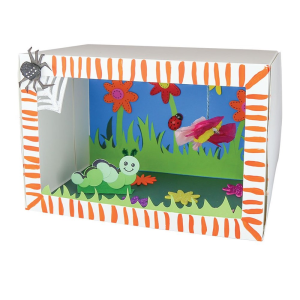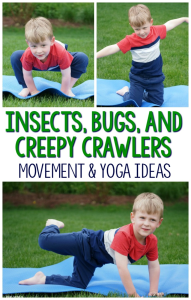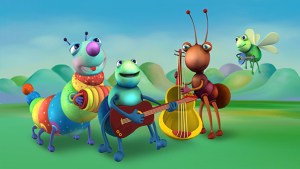Engaging preschoolers in bug-themed activities is a fantastic way to introduce them to the fascinating world of insects and spark their curiosity about the natural environment.
Bugs are captivating creatures with unique characteristics and behaviors, making them a perfect subject for hands-on exploration and learning.
These Bugs Activities for Preschoolers offer a wide range of experiences that promote sensory exploration, fine motor skills, creativity, and scientific inquiry.
Bug Hunt and Exploration:

Take preschoolers on an exciting bug hunt adventure in a nearby park or garden. Provide them with magnifying glasses and bug containers to safely observe and collect bugs. Encourage children to explore different habitats like under rocks, in tall grass, or near flowers. As they discover bugs, help them identify different species and discuss their characteristics. Engage their senses by asking them to describe what they see, hear, and feel. This activity not only fosters a love for nature but also enhances observation skills and introduces children to the diversity of bugs.
Bug Sensory Bin:

Create a sensory bin filled with materials that represent a bug’s environment. Fill a large container with green shredded paper or soil as the base. Add plastic bugs, leaves, twigs, and stones to mimic a bug’s habitat. Encourage children to dig their hands into the sensory bin, feel the textures, and explore the different objects. They can use small containers and tools to scoop, pour, and transfer the materials, fostering fine motor skills. This hands-on sensory experience allows preschoolers to engage their imaginations and learn about bugs in a playful way.
Related: 20 Playful Farm Science Activities for Preschoolers
Bug Life Cycle Craft:

Teach preschoolers about the fascinating life cycle of bugs through a creative craft activity. Provide each child with a paper plate and various craft supplies like construction paper, pom-poms, googly eyes, and pipe cleaners. Instruct them to create different stages of a bug’s life cycle, such as an egg, caterpillar, pupa, and butterfly. They can cut and glue the materials onto the paper plate to represent each stage. This craft not only reinforces the concept of metamorphosis but also enhances fine motor skills and artistic expression.
Bug-themed Storytime:

Organize a bug-themed storytime session for preschoolers. Select age-appropriate books that feature bugs as the main characters or explore bug-related topics. As you read aloud, encourage children to engage in discussions about the bugs in the story, their behaviors, and their habitats. Use props or puppets to make the storytelling session more interactive and entertaining. Afterward, encourage children to draw or paint their favorite bug from the story, further fostering their creativity and imagination.
Related: 20 Fun Dinosaur Preschool Activities
Bug Anatomy Exploration:

Introduce preschoolers to the basic anatomy of bugs through a hands-on exploration activity. Prepare a variety of bug models, posters, or diagrams displaying different bug body parts. Invite children to examine the models closely and identify the various parts, such as the head, antennae, wings, legs, and body segments. Engage their tactile senses by providing clay or playdough for them to mold and create their own bug body parts. This activity not only teaches children about bug anatomy but also promotes fine motor skills and spatial awareness.
Bug Sorting and Counting:

Create a sorting and counting activity using plastic bugs and small containers. Provide preschoolers with a variety of bugs in different colors, shapes, and sizes. Encourage them to sort the bugs based on their attributes, such as color or number of legs, into the corresponding containers. Then, introduce counting by asking children to count how many bugs are in each group. This activity promotes categorization skills, visual discrimination, and early math concepts.
Bug Habitats Diorama:

Guide preschoolers in creating their own bug habitats using shoeboxes or small cardboard boxes. Provide art supplies like construction paper, craft sticks, cotton balls, and pipe cleaners for them to decorate and design their dioramas. Encourage children to recreate different bug habitats, such as a garden, forest, or pond, and populate them with plastic bugs or handmade bug cutouts. This activity not only encourages creativity but also fosters an understanding of different bug habitats and their unique characteristics.
Bug Yoga:

Combine physical activity with bug-themed fun through bug yoga. Introduce preschoolers to simple yoga poses that mimic bug movements and characteristics, such as the butterfly pose or the spider pose. Guide them through a series of gentle stretches and movements, encouraging them to use their imaginations to become bugs. This activity helps children develop body awareness, balance, and coordination while incorporating the bug theme in a playful and engaging way.
Bug Symmetry Art:

Introduce the concept of symmetry to preschoolers through a bug-themed art activity. Fold a piece of paper in half and draw half of a bug on one side. Ask children to complete the other half of the bug, ensuring that it is symmetrical. They can use markers, crayons, or colored pencils to decorate their bugs. Encourage them to experiment with different bug shapes and patterns. This activity promotes fine motor skills, creativity, and an understanding of symmetry in a visually appealing manner.
Bug Snack Creation:

Engage preschoolers in a bug-themed snack creation activity. Provide a variety of healthy ingredients like fruits, vegetables, crackers, and spreads. Show children how they can arrange the ingredients to create bug-inspired snacks, such as cucumber slices with carrot sticks as legs, or apple slices with raisins as eyes. Encourage them to use their imaginations to come up with their own bug snack creations. This activity not only promotes healthy eating but also enhances fine motor skills and creativity in food presentation.
Bug Music and Dance:

Introduce preschoolers to the world of bugs through music and dance. Compile a playlist of songs related to bugs, such as “The Ants Go Marching” or “The Itsy Bitsy Spider.” Play the songs and encourage children to move and dance like the bugs mentioned in the lyrics. They can crawl like ants, flutter their wings like butterflies, or wiggle like worms. This activity promotes gross motor skills, rhythm, and coordination while fostering a sense of fun and creativity.
Bug Puzzles:

Provide preschoolers with bug-themed puzzles appropriate for their age and developmental level. Choose puzzles with varying difficulty levels, ranging from simple two-piece puzzles for younger children to more complex puzzles with multiple pieces for older preschoolers. As children work on the puzzles, encourage them to identify and name the bugs they see. Completing puzzles promotes problem-solving skills, spatial reasoning, and hand-eye coordination.
Bug-Inspired Dramatic Play:

Set up a bug-themed dramatic play area where preschoolers can pretend to be bugs or bug explorers. Provide costumes, hats, magnifying glasses, bug catchers, and bug-themed props. Encourage children to use their imaginations and engage in role-playing activities, such as pretending to search for bugs, build bug homes, or fly like butterflies. This activity enhances social skills, imaginative play, and language development as children engage in cooperative play and storytelling.
Bug Alphabet Match:

Create a bug-themed alphabet-matching activity to help preschoolers with letter recognition. Write uppercase and lowercase letters on separate bug cutouts or cards. Scatter them around the room or place them in a sensory bin filled with rice or shredded paper. Encourage children to find matching pairs of letters and place them together. As they play, reinforce letter names and sounds. This activity promotes letter identification, visual discrimination, and letter-sound correspondence.
Bug Science Experiment:

Engage preschoolers in a simple bug science experiment that demonstrates how bugs move. Place different bugs, such as ants, ladybugs, or beetles, in separate containers with lids. Make small holes in the lids to allow air to circulate. Ask children to observe the bugs and predict how they will move. After a while, discuss their observations and compare the movements of the different bugs. This experiment introduces basic scientific concepts and encourages children to make predictions and draw conclusions based on their observations.
Bug Scavenger Hunt:

Organize a bug-themed scavenger hunt for preschoolers. Create a list of bugs or bug-related items they need to find, such as a ladybug, a leaf with a bug bite, or a spider web. Provide each child with a magnifying glass and a bag or container to collect their findings. Guide them as they search for the items on the list and celebrate their discoveries together. This activity promotes observation skills, critical thinking, and outdoor exploration.
Bug-inspired Sensory Art:

Combine sensory play and art by creating bug-inspired sensory art. Set up different art stations with materials like paint, glue, glitter, tissue paper, and googly eyes. Provide bug-shaped templates or encourage children to create their own bug designs. Let them explore the different textures and materials, using their fingers or brushes to apply the art supplies. The end result will be unique bug-themed artwork that showcases their creativity and sensory exploration.
Bug Anatomy Playdough Mats:

Print out or create playdough mats featuring bug anatomy, such as a bee with labeled body parts. Provide preschoolers with playdough in different colors and encourage them to mold and shape the playdough to match the bug’s body parts on the mat. They can roll small balls for eyes, create long antennae, or mold wings. This hands-on activity promotes fine motor skills, and spatial awareness, and reinforces bug anatomy concepts.
Bug Bingo:

Play a bug-themed version of Bingo with preschoolers. Create Bingo cards with pictures of different bugs instead of numbers. Show pictures or flashcards of bugs and ask children to find and cover the matching bug on their Bingo cards. The first child to cover a line or complete their entire card shouts “Bug Bingo!” This game promotes visual recognition, attention to detail, and listening skills in a fun and interactive way.
Bug Relay Race:

Organize a bug-themed relay race for preschoolers to enjoy. Divide children into teams and set up a racecourse with various bug-related challenges along the way. For example, they might have to crawl through a tunnel-like a bug, balance a beanbag on their heads as they walk like ants, or hop like grasshoppers to reach a finish line. This activity promotes gross motor skills, teamwork, and physical fitness while incorporating the bug theme into an energetic and exciting game.


2 Responses
Hello, I have written to you before and have yet to hear back. You are using my images in an unethical way that I do not permit. Please remove all of my images from your website unless you are going to correctly cite me. Again, you do not have permission to use my images without proper and ethical citation.
I have seen your comment just now. I have told my content uploading team to remove your website’s images right away. I guess they didn’t cite the resource correctly. For further information, what’s the correct way to cite your web content? Can you guide us? Thanks.